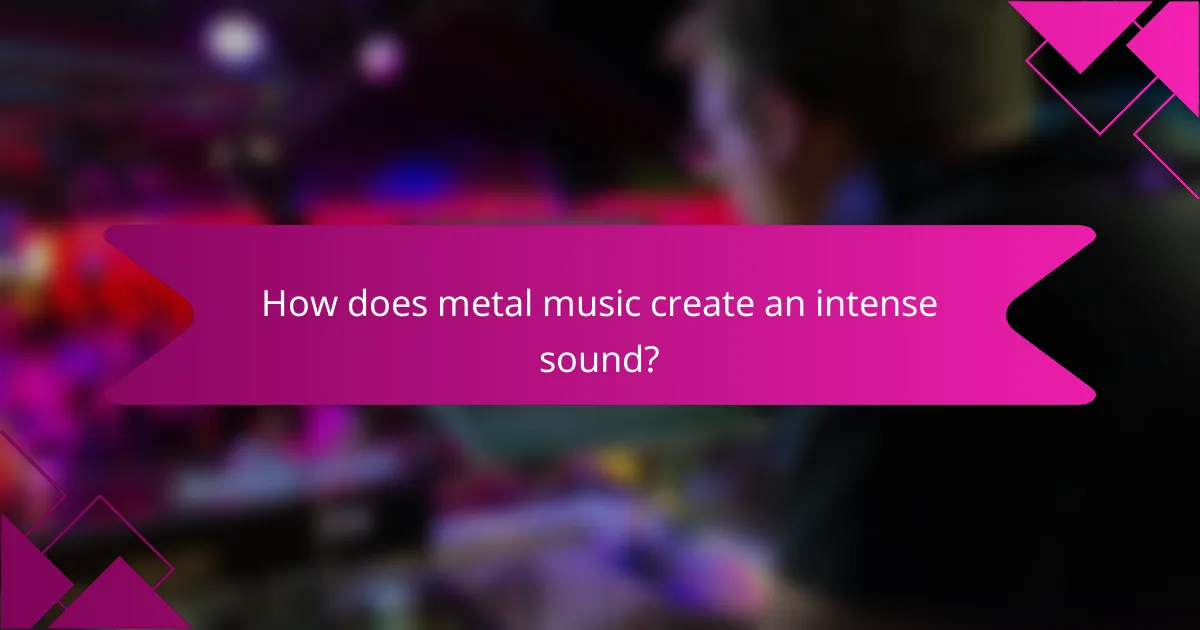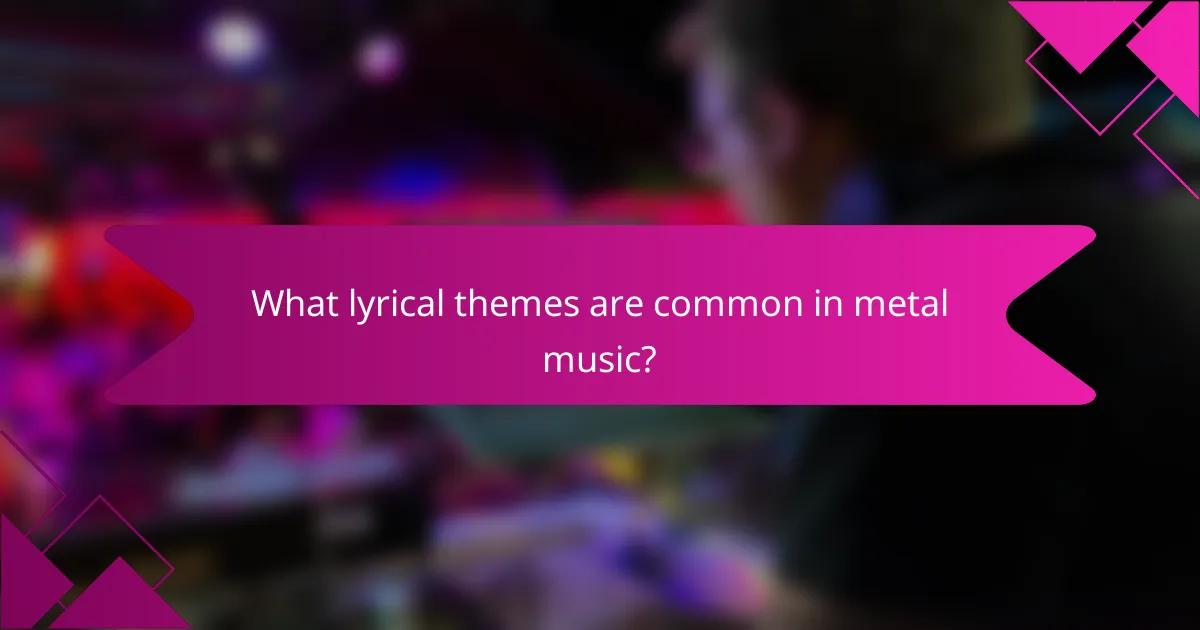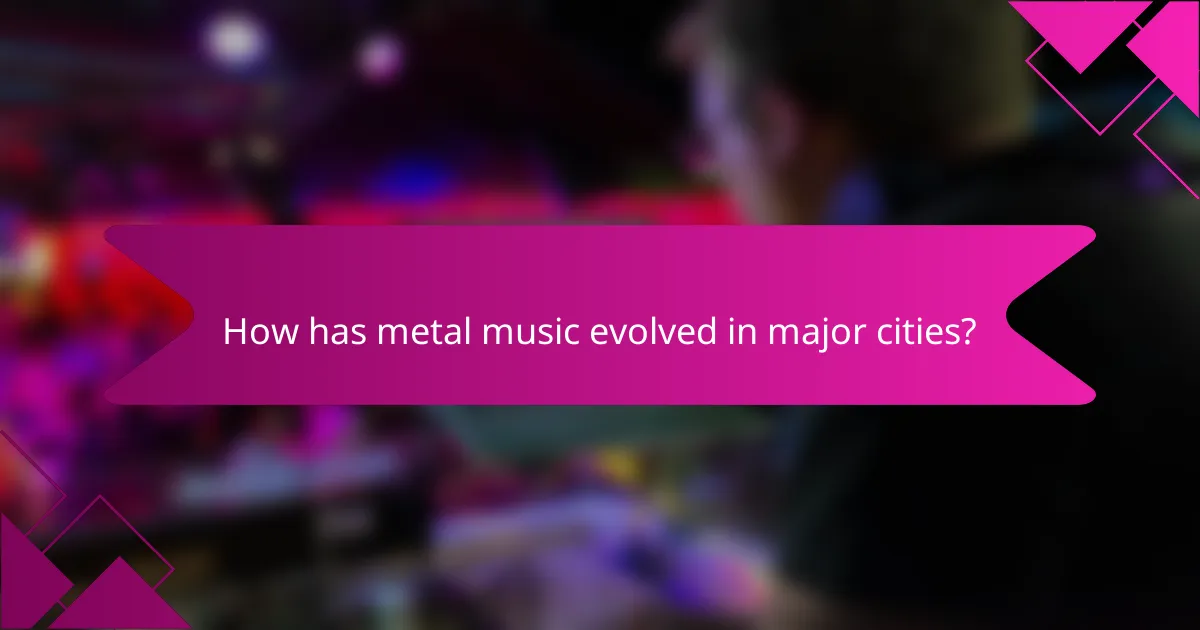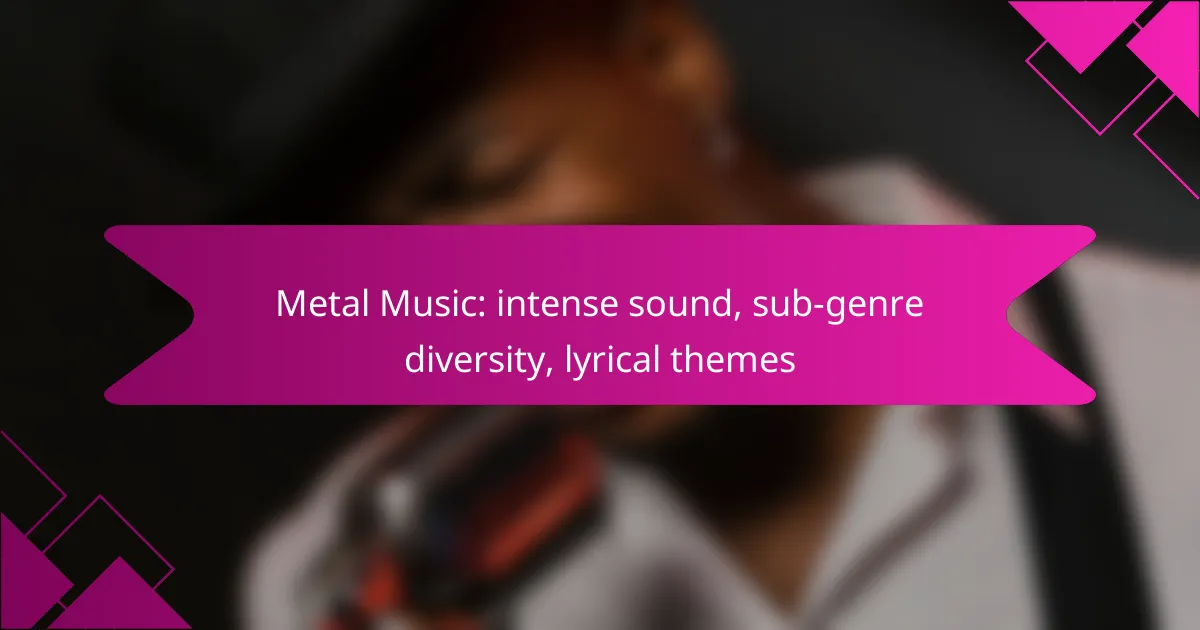Metal music is characterized by its intense sound, achieved through heavy instrumentation, aggressive rhythms, and powerful vocal techniques, creating an immersive experience for listeners. With a rich diversity of sub-genres such as heavy metal, death metal, and black metal, each offers unique characteristics and appeals to various audiences. The genre also delves into thought-provoking lyrical themes, exploring topics like dark fantasy, social issues, and personal struggles, which add depth and emotional resonance to its powerful sound.

How does metal music create an intense sound?
Metal music creates an intense sound through a combination of heavy instrumentation, aggressive rhythms, and powerful vocal techniques. These elements work together to produce a sonic experience that is both immersive and energizing, appealing to a wide range of listeners.
Heavy guitar riffs
Heavy guitar riffs are a cornerstone of metal music, characterized by their aggressive tone and complex structures. These riffs often utilize techniques like palm muting and alternate picking to create a driving force that captures the listener’s attention. Iconic examples include the opening riffs of songs by bands like Metallica and Black Sabbath.
Riffs can vary in complexity, from simple power chords to intricate solos, allowing for a wide range of emotional expression. The use of minor scales often enhances the dark and intense atmosphere typical of metal music.
Fast-paced drumming
Fast-paced drumming is essential in metal, providing the energetic backbone that propels the music forward. Drummers often use double bass pedals to achieve rapid beats, creating a relentless rhythm that matches the intensity of the guitar work. This technique can be heard in tracks by bands like Slayer and Lamb of God.
The drumming style in metal can range from straightforward rock beats to complex polyrhythms, adding layers of depth and excitement. Effective drumming not only supports the music but also enhances the overall intensity of the performance.
Powerful vocals
Powerful vocals are a defining feature of metal music, often employing techniques such as growling, screaming, and soaring melodies. These vocal styles convey a wide range of emotions, from aggression to vulnerability, and are crucial for delivering the lyrical themes typical of the genre. Bands like Iron Maiden and Slipknot exemplify this diversity in vocal expression.
Vocalists often use dynamic range to enhance the intensity, shifting from soft, melodic passages to powerful, high-energy screams. This contrast keeps listeners engaged and adds to the overall impact of the music.
Use of distortion
The use of distortion is fundamental in creating the heavy sound associated with metal music. Distortion effects are applied to electric guitars and basses to produce a gritty, aggressive tone that is both powerful and distinctive. This effect can be adjusted to achieve various levels of intensity, from subtle overdrive to full-on fuzz.
Different types of distortion pedals and amplifiers can yield unique sounds, allowing musicians to tailor their tone to fit their style. Experimenting with these effects can lead to innovative sounds that push the boundaries of traditional metal music.
Dynamic song structures
Dynamic song structures in metal often feature shifts in tempo, key, and intensity, creating a sense of unpredictability that keeps listeners engaged. Songs may alternate between heavy, fast sections and slower, more melodic passages, enhancing the emotional impact. This approach is evident in progressive metal bands like Dream Theater.
Incorporating various sections such as verses, choruses, and bridges allows for storytelling within the music, making each song a unique journey. Musicians should consider how these dynamics can enhance their compositions and connect with their audience.

What are the main sub-genres of metal music?
The main sub-genres of metal music include heavy metal, death metal, black metal, thrash metal, and progressive metal. Each sub-genre has distinct characteristics in terms of sound, lyrical themes, and musical complexity, appealing to different audiences within the metal community.
Heavy metal
Heavy metal is characterized by its loud, aggressive sound, often featuring distorted guitars, powerful vocals, and emphatic rhythms. Bands like Black Sabbath and Led Zeppelin laid the groundwork for this genre in the late 1960s and early 1970s.
The lyrical themes in heavy metal often explore topics such as rebellion, fantasy, and personal struggles. This sub-genre typically has a straightforward song structure, making it accessible to new listeners.
Death metal
Death metal is known for its extreme sound, featuring heavily distorted guitars, deep growling vocals, and complex song structures. Originating in the mid-1980s, bands like Death and Cannibal Corpse are pivotal in defining this style.
Lyrically, death metal often delves into themes of mortality, violence, and the macabre. The genre frequently employs rapid tempo changes and intricate guitar solos, appealing to those who appreciate technical musicianship.
Black metal
Black metal is distinguished by its raw sound, high-pitched shrieking vocals, and atmospheric elements. Emerging in the early 1980s, bands like Mayhem and Burzum have become synonymous with this genre.
Thematically, black metal often explores darkness, nature, and anti-religious sentiments. Its production is typically lo-fi, creating an eerie and haunting atmosphere that resonates with its audience.
Thrash metal
Thrash metal combines elements of heavy metal and punk rock, characterized by fast tempos, aggressive guitar riffs, and energetic drumming. Bands like Metallica and Slayer were instrumental in popularizing this sub-genre during the 1980s.
Lyrically, thrash metal often addresses social issues, war, and political themes. Its high-energy performances and complex arrangements make it a favorite among fans who enjoy intense live shows.
Progressive metal
Progressive metal blends metal with progressive rock, featuring complex song structures, intricate instrumentation, and varied time signatures. Bands like Dream Theater and Tool exemplify this genre’s emphasis on musicianship and creativity.
The lyrical content in progressive metal often explores philosophical concepts, personal introspection, and science fiction themes. This sub-genre appeals to listeners who appreciate a more cerebral approach to music, often resulting in longer, more elaborate compositions.

What lyrical themes are common in metal music?
Metal music often explores a variety of intense and thought-provoking lyrical themes, reflecting its diverse sub-genres. Common themes include dark fantasy, social issues, personal struggles, mythology and history, and existentialism, each contributing to the genre’s depth and emotional resonance.
Dark fantasy
Dark fantasy in metal music often delves into themes of magic, mythical creatures, and otherworldly realms. Bands like Blind Guardian and Nightwish frequently incorporate elaborate storytelling that transports listeners to fantastical landscapes filled with epic battles and heroic quests. This theme allows for rich imagery and a sense of escapism, appealing to fans who enjoy immersive narratives.
Lyrics in this sub-genre may include references to classic literature, folklore, and even original tales, creating a vivid tapestry of sound and story. The combination of heavy instrumentation and fantastical lyrics enhances the overall intensity of the music.
Social issues
Many metal songs address pressing social issues, including inequality, war, and political corruption. Bands like System of a Down and Rage Against the Machine use their platform to critique societal norms and injustices, often sparking conversations among listeners. This theme resonates with fans who seek music that reflects their frustrations and aspirations for change.
Lyrics may incorporate direct references to current events or broader societal critiques, making the music not only entertaining but also a form of activism. Engaging with these themes can foster a sense of community among fans who share similar values and concerns.
Personal struggles
Personal struggles are a prevalent theme in metal, often focusing on issues like mental health, addiction, and heartbreak. Bands such as Metallica and Slipknot explore these topics with raw honesty, allowing listeners to connect on a deeply emotional level. This theme provides an outlet for both artists and fans to express and confront their inner demons.
Lyrics often reflect personal experiences and vulnerabilities, creating a cathartic experience for listeners. The intensity of the music amplifies these themes, making them relatable and impactful.
Mythology and history
Mythology and history serve as rich sources of inspiration for metal lyrics, with many bands drawing from ancient tales and historical events. Groups like Amon Amarth and Sabaton often weave narratives that highlight legendary figures, battles, and cultural myths. This theme not only entertains but also educates listeners about various cultures and their histories.
Lyrics may include detailed accounts of historical battles or mythological stories, often accompanied by powerful instrumentation that enhances the epic nature of the themes. This approach allows fans to engage with history and mythology in a dynamic way.
Existentialism
Existentialism in metal music grapples with questions of existence, purpose, and the human condition. Bands like Opeth and Tool explore philosophical concepts, prompting listeners to reflect on their own lives and beliefs. This theme can be both thought-provoking and unsettling, challenging fans to confront their own existential dilemmas.
Lyrics often pose deep questions or present abstract ideas, encouraging introspection. The complex musical arrangements typically found in this sub-genre further enhance the contemplative nature of the themes, making for a profound listening experience.

How has metal music evolved in major cities?
Metal music has evolved significantly in major cities, driven by local scenes that foster unique sub-genres and lyrical themes. Each city contributes its distinct sound, influenced by cultural, social, and historical contexts.
Emergence of local scenes
Local metal scenes have emerged in cities around the world, creating diverse sub-genres that reflect regional influences. For example, cities like Los Angeles are known for glam metal, while Seattle has a reputation for grunge-influenced metal.
These scenes often arise from grassroots movements, where local bands perform in small venues, fostering a community of fans and musicians. As these bands gain popularity, they attract attention from record labels, further solidifying the local scene.
To support local metal scenes, fans can attend shows, promote local bands on social media, and participate in community events. This engagement helps sustain the vibrancy of metal music in their cities and encourages the growth of new talent.
